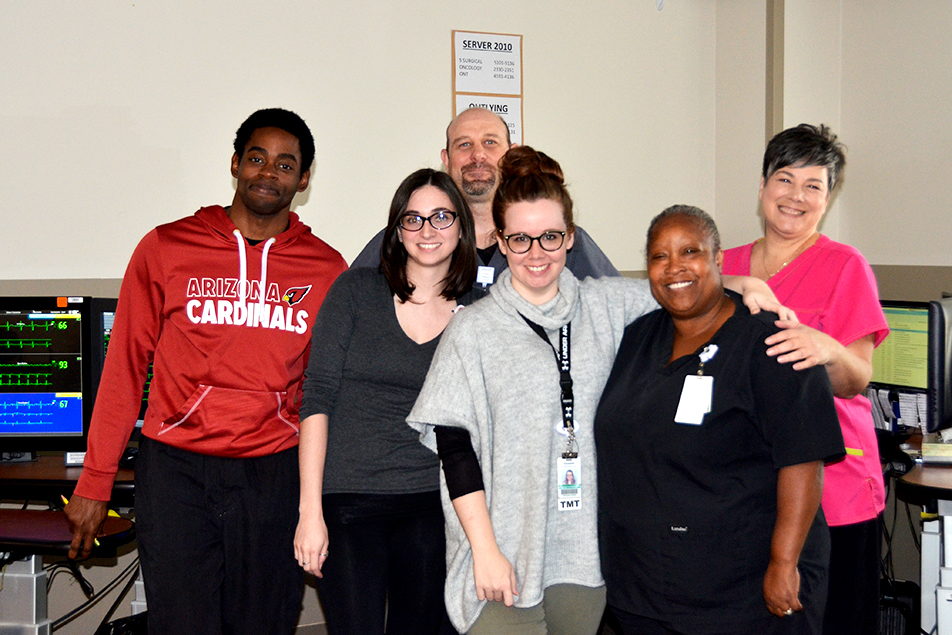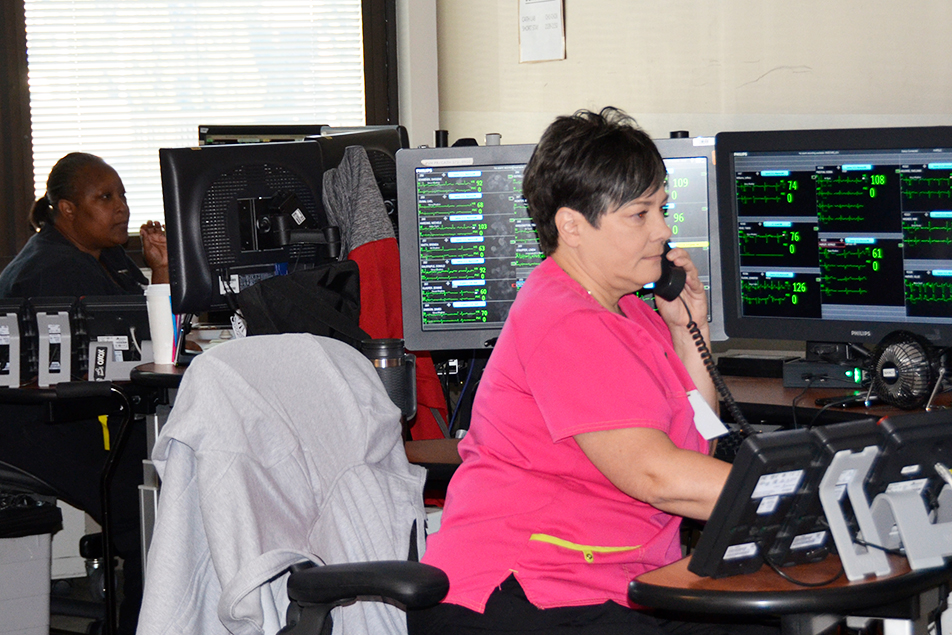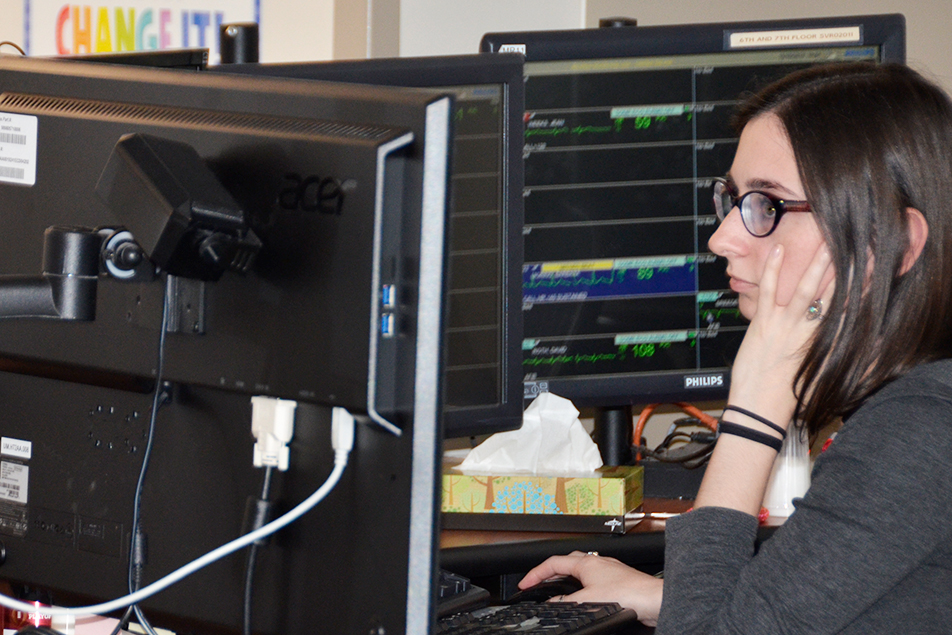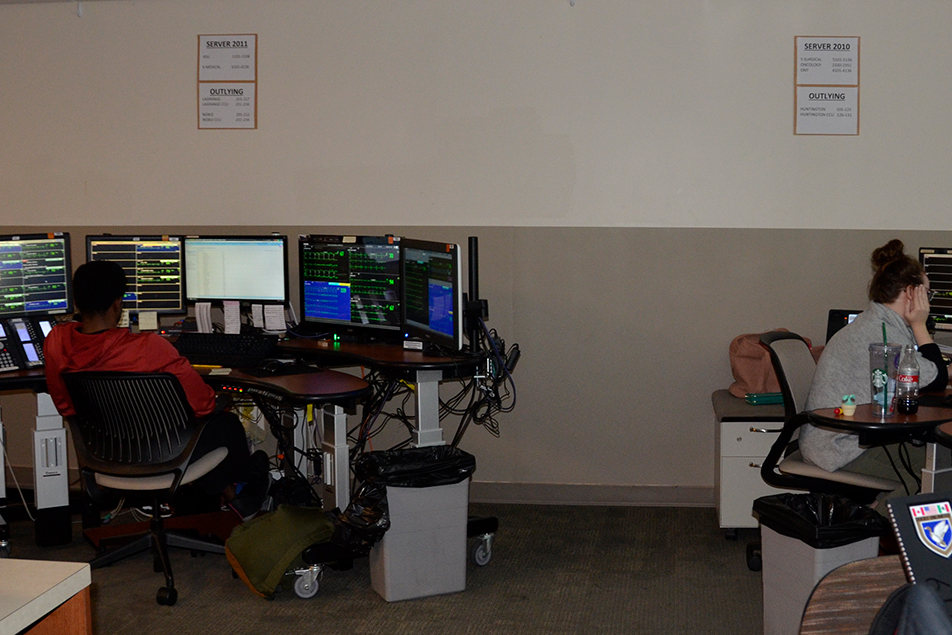
If you walk just past the Ronald McDonald House at Parkview Regional Medical Center (PRMC), you’ll come upon a sign on the left-hand side that reads “Heart Station”. On the other side of that door, an unsynchronized symphony of beeps and tones plays to the ears of a handful of specially trained technicians. This is a team of hidden heroes, behind the scenes, tuning into the rhythms and beats of Parkview patients around the clock.
Also referred to as the Central Monitoring Station, the Heart Station is where the readings from all of the heart monitors from all of the Parkview Community hospitals, Parkview Hospital Randallia and PRMC are sent. The room is divided into six pods, each a designated station gathering data from a different location or area of the health system. One telemetry monitor technician (TMT) supervises each pod, their eyes constantly scanning across and back and forth between a set of four screens. On each monitor, a grid of boxes flutters with different zig zag lines and pulses, which are a reflection of patients’ heart beats and rhythms.
The room throbs and vibrates with constant activity, which can be overstimulating for a first-time visitor, but not for a veteran like Nancy Hook, telemetry monitor technician. On a typical day, when you’ll often find her at her favorite pod supervising all of Randallia, Nancy has no problem keeping track of, on average, well over 40 patients.
Nancy has been with Parkview for more than 35 years. She graduated from the Parkview School of Nursing and worked as a floor nurse for a decade. When the opportunity presented itself, she transitioned to the Heart Station, where she’s been happily keeping tabs on cardiac activity for the past 25 years.

“If you have 54 patients who are all doing great, that’s wonderful, but if you have 54 patients and a lot of them are having a bad day, it can get pretty busy,” Nancy said. “But I love it. To be a TMT, you have to be able to multitask. It’s not for everyone.”
Nancy described the crossroads where the Heart Station team and technology meet as, “a partnership between the algorithm of the machine and the training and instinct of human beings.” The heart rate monitors can clue the TMTs and care team into only so much before it’s imperative that a set of human eyes intervene.
It’s hard to deny (or ignore) the immutable parade of dings ringing through the office. But over time, one’s senses become sharp, and they learn to distinguish, with expert ears, between color and pitch, and discern when a ding is something more.
“Honestly, now it’s kind of white noise to me until it reaches a certain level,” Nancy said. “We get a lot of blue alerts, which mean there’s something malfunctioning in relation to the equipment. This could be because someone is in the shower, or their monitor needs a new battery. I’ll call the nurse and find out what’s going on, and then follow up every 15 minutes or so until the machine comes back online. These alerts are a lower tone and really never stop coming in.”
The team also receives a large amount of yellow alarms, which indicate a low- or mid-level priority cardiac rhythm. This can include arrhythmias, atrial fibrillation (Afib) or atrial flutter, abnormal rate control, premature ventricular contractions (PVC) or any trend or instance that falls outside of the guidelines set by the patient’s care team.
When a tone comes in at a higher pitch, that’s typically a red alert. A red alarm is the highest priority, and can indicate a potentially lethal rhythm. “When we get a red alert, we look into it and call the nurse on the floor so they can go in and get eyes on the patient. The faster we respond, the better the outcome. A red alarm rings for ventricular tachycardia (VT), ventricular fibrillation (VFib), agonal respiration, asystole (cardiac arrest), severe bradycardia or severe tachycardia,” Nancy said.

According to Nancy, everyone’s normal is different. Part of the TMT’s role is to learn each patient’s patterns so that they can quickly identify any abnormal activity. “When we see something of concern, we pull a strip and contact the nurse. Sometimes it’s just a gut feeling that something doesn’t look right.”
Every action the TMTs take are charted for reference, and the machines record and store the patient’s every beat for 96 hours, which is important, because the techs can’t have eyes on the monitors at all times.
The full-time team members take three 12-hour shifts each week and part-time team members two 12-hour shifts, and most of them choose their shifts on consecutive days, so they really get to know the patients and their rhythms. “That first day we’re typically assessing and getting to know the patient. The nurse will share details about the patient and the plan for care,” Nancy said. “At shift change, we pass a report to the TMT taking over on each and every patient.”
The TMTs are very proficient in rhythms, a fact that Nancy, as the primary team educator, takes great pride in. But that’s just scratching the surface. Every new TMT takes a two-week course, where they will study the contents of two very sizable binders filled with information. “They have to know devices, because if someone has a pacemaker, for instance, that will impact their readings. They have to know some chemistry, pharmacology, cardiac anatomy, electrophysiology, and the effects of drugs and alcohol,” Nancy, who teaches the course, said. It’s not an easy curriculum, and she has become an expert at determining who will complete the training. “I can tell by the third or fourth day if someone is going to make it. It takes a lot of memorization, which doesn’t come easily to everyone.”

Each new tech will then sit with a seasoned TMT and observe for six weeks. “If you’re comfortable before a year, you’re over-confident,” Nancy said. Memorizing the rules of cardiac monitoring is vital, but true experience is imperative. “I can teach the book, but until you actually see it in real life, you can’t imagine the job.”
The Parkview central monitoring program has had a lot of success. Several techs have gone on to work in other areas of the hospital, such as Pediatric Cardiology, or work on similar programs at other health systems. “It’s like watching your kids grow up and go do great things,” Nancy said.
The team consists of a collage of co-workers from different career backgrounds. Todd Krueckeberg, telemetry monitor tech, is also a Pogue volunteer firefighter. “It’s interesting, because when you work on the truck, you don’t always get that follow-up on patients. Here, I see the other side.” As an advanced EMT, Todd had the advantage of being familiar with rhythms, but that’s not true for everyone in the group.
Janice Shears, telemetry monitor tech, worked in registration at the hospital before joining the team. “I wanted to know how things worked on the backend,” she said. Admittedly, she struggled with the course work. “It was tough! It felt like going back to school with all of that studying. You definitely have to want to learn.” She celebrated three years with the team in June.
Ask a different tech their background and you’ll likely get a completely different response. Travis Bright, telemetry monitor tech, worked in Nutrition Services, delivering room trays before making the shift. “I wanted something full time, and my mom was a TMT,” he said.
The diverse perspectives and experiences only strengthen the team, which is extremely close. “It’s the same with the night shift,” Nancy said. “We’re like a little family. We know when to step in, when someone needs something. We have each other’s backs.”
That closeness is important, for a team that often feels … well, faceless. “I know a lot of nurses’ voices, but we’ve never met face-to-face, and that’s OK,” Nancy shrugged. “It’s our responsibility to know what’s going on with patients. The nurse has that face time with the patient and the physician. We want to give that nurse the best, most accurate information so that he/she is empowered to collaborate with the patient’s entire care team. It takes a lot of trust to let go of some of the control of your patient’s care, and we take a lot of pride in the rapport we have with the clinicians.”
While it’s true their tireless efforts transpire behind a door few people ever notice, the impact of their work is undeniably tremendous. “We’re this quiet entity, but we know our work is so important,” Nancy said. “Even if people don’t necessarily know we’re here watching, we know we help save lives, and that’s enough for us.”



